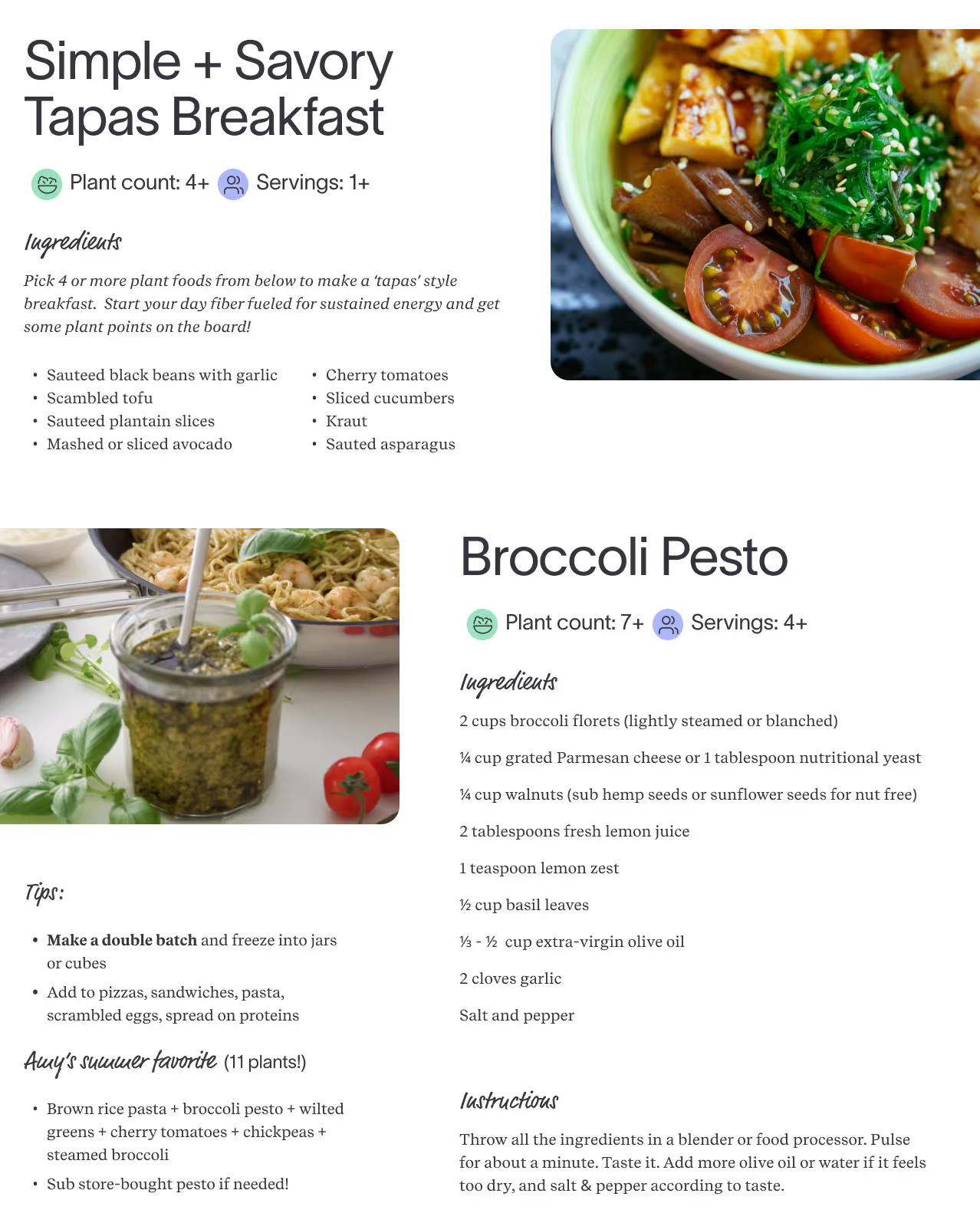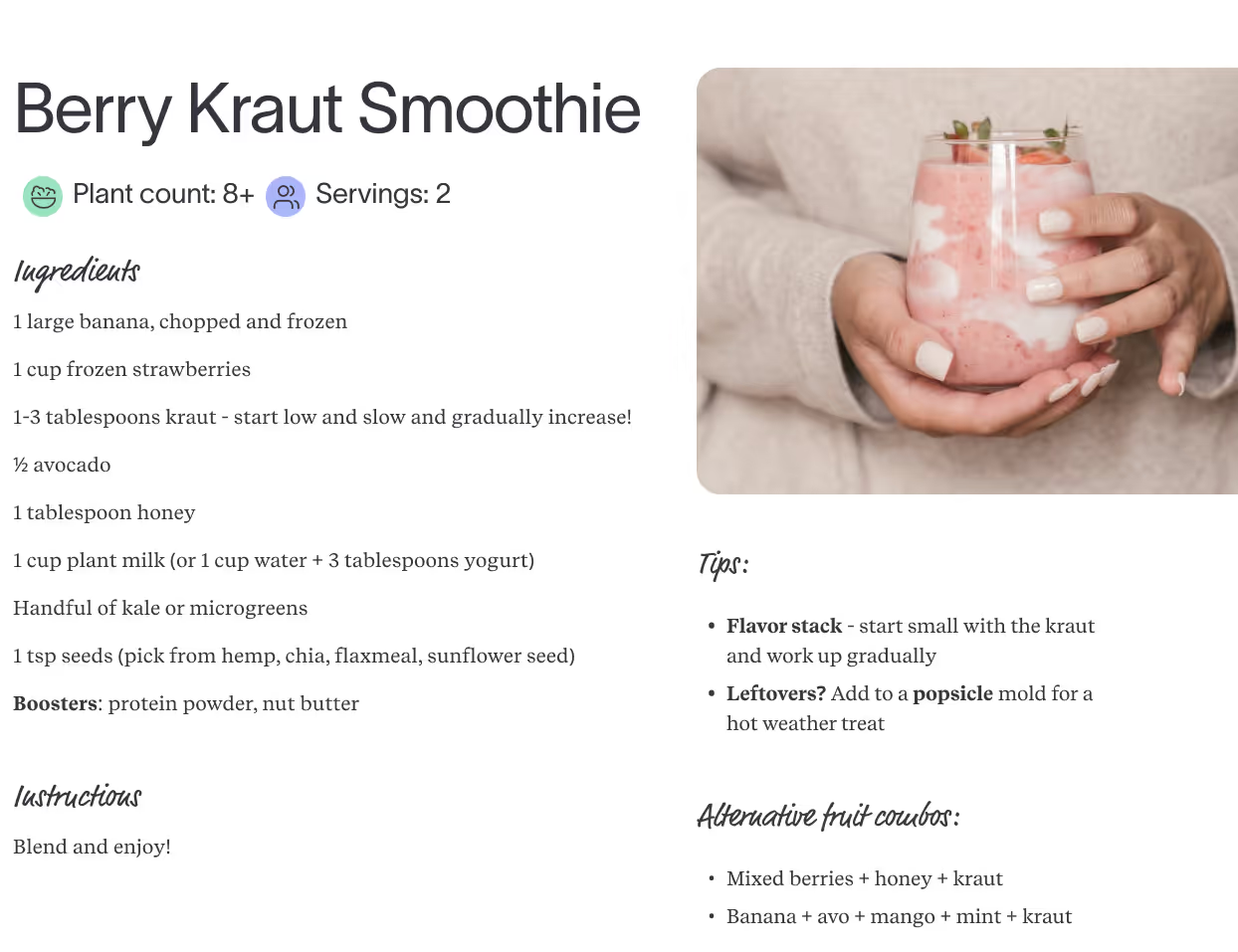At Tiny Health, we’re all about helping your family’s gut thrive, and a key part of that is eating 30 plants a week. Why 30? Research shows that eating a wide variety of plant foods each week supports a more diverse and resilient gut microbiome.
Different microbes feed on different foods, so the more types of plants you eat, the more beneficial bacteria you can nourish. From fiber to plant compounds like polyphenols, each one helps shape a gut that’s more balanced and resilient.
So, how do you get 30 plants a week onto your plate? It’s more doable than it sounds, especially with expert tips. Our microbiome specialists shared their favorite ways to make it happen. No stress. No overhauls. Just real-life ideas that fit into your routine, even with a picky eater at the table.
Why 30 different plants a week matters
We’re creatures of habit. Eating the same foods over and over is easy, but it’s not the best for your gut health.
That’s where variety comes in. Eating a range of plants—often called eating the rainbow—can give your gut the nutrients it needs to function at its best. Each color represents different phytonutrients, which feed different types of beneficial bacteria. And the research backs it up.
One large-scale study from the American Gut Project found that people who eat 30 different plants a week had significantly higher gut microbiome diversity (a pillar of a healthy gut) compared to those who ate fewer than 10 [1]. That matters because greater microbial diversity is often linked to better digestion, stronger immunity, and lower risk of chronic disease.
Another study showed that variety plays a key role in how well your body absorbs and uses important vitamins and minerals. Your gut microbes don’t just digest food; they help regulate the bioavailability of nutrients [2].
A shocking 77% of those who’ve taken a Tiny Health test report eating 15 or fewer unique plants each week. That’s half of what they need to support their gut in a meaningful way. But the news isn’t all discouraging: 47% say they started eating a greater variety of plants by following their Action Plan.
That’s why we encourage families to eat more plants and track their intake with a 30-plants-a-week checklist.
What counts toward your 30 plants a week checklist?
Any whole or minimally processed plant-based food you eat or drink counts toward your 30. So if you're eating something with multiple plant ingredients—like a soup with lentils, carrots, spinach, and a handful of cilantro—you’d count each of those separately. Every bit adds up.
This isn’t just about fruits and vegetables either. A good 30 plants a week tracker includes ingredients from all of these categories:
- Vegetables (fresh, frozen, fermented, or cooked)
- Fruits (yes, avocados count)
- Whole grains like oats, brown rice, barley, and farro
- Legumes like lentils, black beans, and edamame
- Nuts and seeds (from walnuts to chia to sunflower)
- Herbs and spices (Try for a tablespoon or more to count it)
- Plant-based extras like cacao, coffee, and tea
How to think about plant variety while shopping
Now that you know what counts toward 30 plants, you can make grocery shopping more strategic. Along with planning meals, try looking at your cart through the lens of diversity:
Are you pulling from different plant groups?
Do you see a mix of colors, textures, and flavors?
Is there at least one new-to-you plant?
This simple shift can help you create a more balanced diet. And in turn, lead to a more resilient gut.
Another thing to remember is that you don’t need 30 servings. Just 30 unique types over the week.
How to eat more plants every day
Trying to eat 30 plants a week doesn’t mean every meal has to be a giant salad. Here are some simple, doable ways our experts make it work. Plus, some everyday ideas that make hitting thirty super easy.
Pro tips from our microbiome specialists
Use a plant-based shake mix with water or plant milk to sneak in dozens of plant foods, no prep needed. - Star Edwards
Wash, cut, and store fruit and veggies right after returning from the market. Then they’re all ready to grab and go when the week gets busy. - Emily Cerda
Eat sautéed veggies or ferments as a side with eggs. Ferments are my favorite way to get an extra veggie in that I don’t have to cook! - Danielle Shea Tan
Buy two new foods each week from the Rainbow Food list and experiment with adding these to meals. Starting small and gradually increasing makes this a sustainable habit for getting more plant foods! - Amy Orlandi
Swap out one packaged snack for a whole food each week (i.e., instead of fruit rolls, buy berries, swap chips for hummus and crackers). - Amy Orlandi
5 more easy ways to get more plants in
These quick, low-effort ideas can help boost your plant count throughout the week:
- Blend a smoothie with coconut or almond milk, then toss in fruits, veggies, seeds, almond butter, and oats
- Swap your usual lettuce for a mix of leafy greens—think arugula, spinach, and romaine
- Sip on chai or spiced herbal teas made with cinnamon, cardamom, ginger, and clove; each spice adds to your count
- Build poke-style bowls with 5+ plants in one go—grains, greens, protein, herbs, seeds
- Roast a colorful tray of veggies like carrots, zucchini, red onions, and bell peppers
Sample recipes for plant-packed days
Need inspiration for a 30-plant-a-week meal plan? Here are some recipes to get you started.



If you’ve got kids, our bento box lunch ideas make packing healthy meals for school a breeze. And when the whole family’s eating in, these crowd-pleasers will keep everyone satisfied while giving their gut some extra love.
Make plant diversity your new normal
Ask any of our microbiome specialists about creating healthy habits, and they’ll likely say that small changes can have a big impact. And perfection isn’t the goal. Adopt a few tips you learned here, keep the momentum up for a few weeks, and soon enough, plant-forward meals will be second nature.
One of the perks of making 30 plants a week part of a healthier lifestyle? You can reshape your gut in powerful ways. Plus, tracking your gut health progress over time is easy when you have a baseline. Our Adult Gut Health Test can show you where your microbiome stands today, including how diverse and resilient it is. You can check in every 6 months or so, see what’s working and what needs fine-tuning.
Diversity takes a plant-based diet to the next level, so you’re not just building a better plate; you’re supporting your overall health.


